Recently we decided to make a change in the format of our dive reports moving from weekly/per trip reports to a summarized format. Unfortunately poor weather sometimes makes the reports pretty sporadic and of course that does not inspire making plans to go diving, so we’ve decided to focus on the big picture. And with that, let’s get into it!
We all recall spring got off to a very rainy start. It was a constant push to make it happen, but we did! I knew eventually I’d be wearing shorts and sporting an embarrassing “crocs tan” on my feet, it was just going to require a little patience!
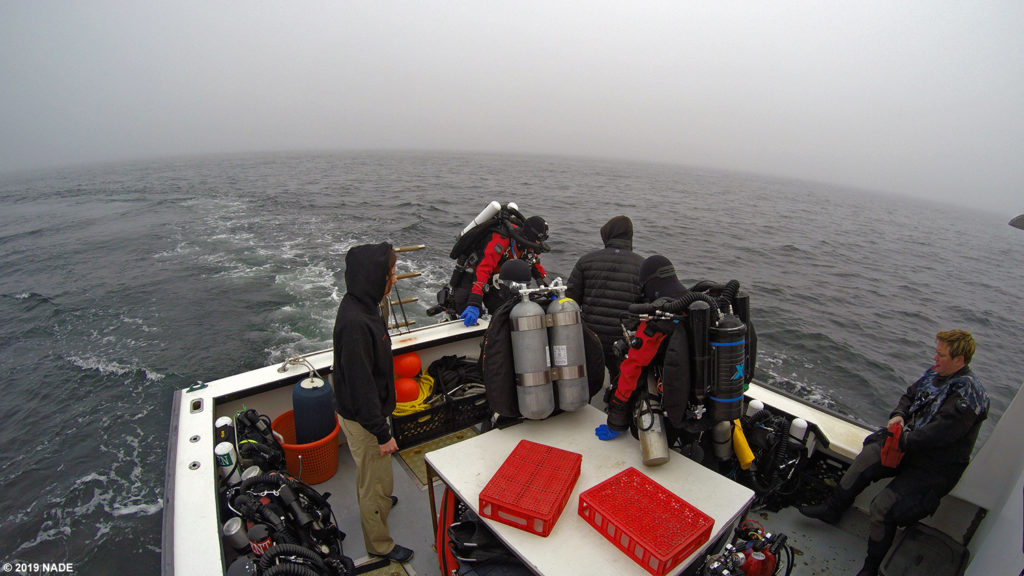
The tie-in team waiting for the OK to be dropped in on the Patriot shipwreck.
June arrived with cold, damp and foggy conditions on a number of occasions. However, surprisingly we made it out to the wreck of the Patriot in very early June, which is somewhat unusual especially if the weather hasn’t been cooperating. We had some strange currents though and that first trip was a challenge–strong current wasn’t lining up with the slack window and it took two tries to get tied in because the divers were pulling the shot line away from the wreck trying to get down. It was definitely one of those days! However, the efforts were worth it because we had some very nice visibility down there despite the current.
We had a little extra work to do, but we got the mooring installed, which provided easy access for all the charter boats over the season, and of course we appreciate the collaboration with NOAA’s Stellwagen Bank National Marie Sanctuary staff in managing diving access in a reasonable way on modern shipwrecks.
From there, we turned our focus to some local Mass Bay wrecks like the New York Central 14-2, which is a site we like for training because we can get students in the 110-120′ depth range, making a nice bridge from the one hundred footers to the 150+ range wrecks. However, in the last few years, mother nature has not been kind to this wreck and it has collapsed considerably. In fact, the wreck is like a fragile shell made out of cheesecloth. I am not even sure it’s such a good idea to be going inside the wreck given how fragile structures seem to be.
The other thing that is noteworthy about this season is we’ve done some upgrades to our camera equipment. Dave wanted a “big kids camera” and I finally decided to buy a drone, which I flew for the first time off the boat after a few short flights in the house (which are no longer allowed after a crash put a few chop marks in the wall and some furniture). The combo of a DSLR, and the Sony A6500 video system with Light & Motion 9600 lumen lights, and the drone, gives us some nice tools to step up our media. Check out this video from the Chester Poling:
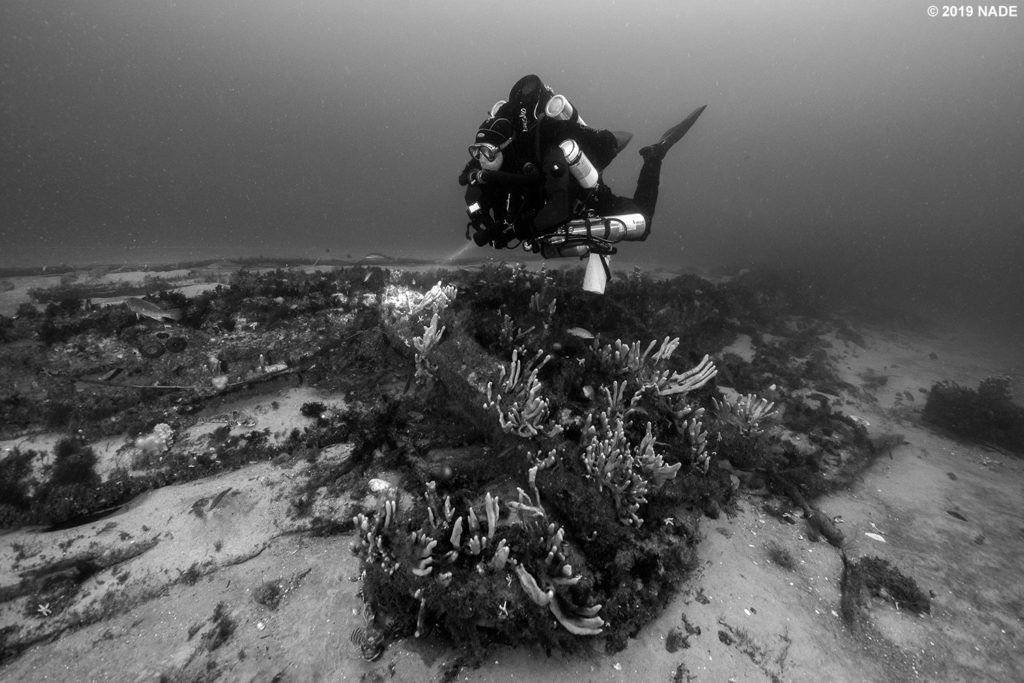
John swimming along the starboard side almost at the stern, the current was quite strong and we had a fast ride back to the bow.
June went by in a hurry and before we knew it the July 4th holiday weekend was upon us. Wow. This is about when we started getting some really nice weather though, so we didn’t complain too much. Over the long weekend, we had the opportunity to support a project involving MIT Sea Grant focused on photographing Stellwagen Bank National Marine Sanctuary via a Hollings Grant. We had perfect weather for the long haul to the Paul Palmer–and excellent visibility too. We had been focusing on mid/late August for Paul Palmer trips in the recent past to take advantage of the warmer water for seeing the most marine life. However, we were finding the visibility wasn’t as good. With an early July trip, we were definitely treated to some nice visibility, although the wreck wasn’t as loaded with sculpin and other fish we’re used to seeing. In fact, the Patriot really never blossomed this year with any high density marine life. I suspect this has to do with the lower concentration of sand lance which has affected even whale activity in the area.
As July progressed, we moved into our exploration dives, focusing on our long-running project “SAS-11” which has been such a challenge, partly due to weather getting in our way, and partly because the wreck is in three distinct pieces and suffers from the typical conditions we find on the deeper wrecks that are in muddy/silty basin type areas–very poor visibility at times. However, we planned carefully since we really wanted to confirm the identify of the wreck and dedicated an entire weekend to the project in addition to several other dates.
With some well-coordinated teamwork, we were able to focus on one particular part of the wreck, taking measurements that allowed us to finally exclude one of the two possible wrecks definitively and confirm the specifications matched with the wreck we suspected it to be. We plan to make an announcement soon and present on the project in 2020.
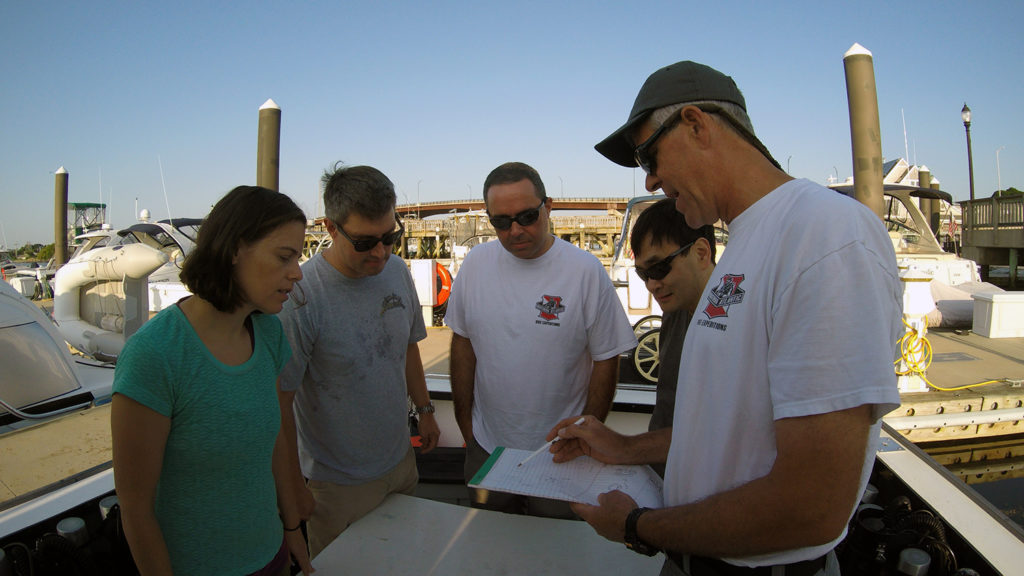
Careful planning and teamwork for the SAS-11 project led the team to success.
Before we knew it, it was early August. We looked forward to our trip to the Pinthis, although this must be one of the latest points in the season we’ve visited this wreck, as it is a popular dive and we usually try to get to it earlier. Weather didn’t cooperate earlier in the season, but we were finally there.
Another charter boat placed a mooring on the wreck, which was nice since we seem to be the only ones that do them anymore. We got tied off and diving right away. Visibility was excellent as it usually is on the Pinthis. And of course, we noted as we do each year that the wreck just continues to crumble. The interior gets smaller and smaller each year, with some sections completely transformed or no longer accessible.
As I see these wrecks aging it reminds me that wreck diving in this area 20 years from now, maybe even 10 years from now, will look drastically different. The shallow wrecks will mostly be debris fields like the Romance and City of Salisbury. Not that they won’t be good dives, but we’re really quite lucky to have had wrecks like the Pinthis and the Poling so accessible with semi-intact/intact structures. It is too bad we’ve never been able to implement any kind of reefing program for old ships in Mass Bay. It would really enhance the diving community, and create reefs for sport fisherman, getting people out on the water having adventures. But I guess we needed casinos more instead…
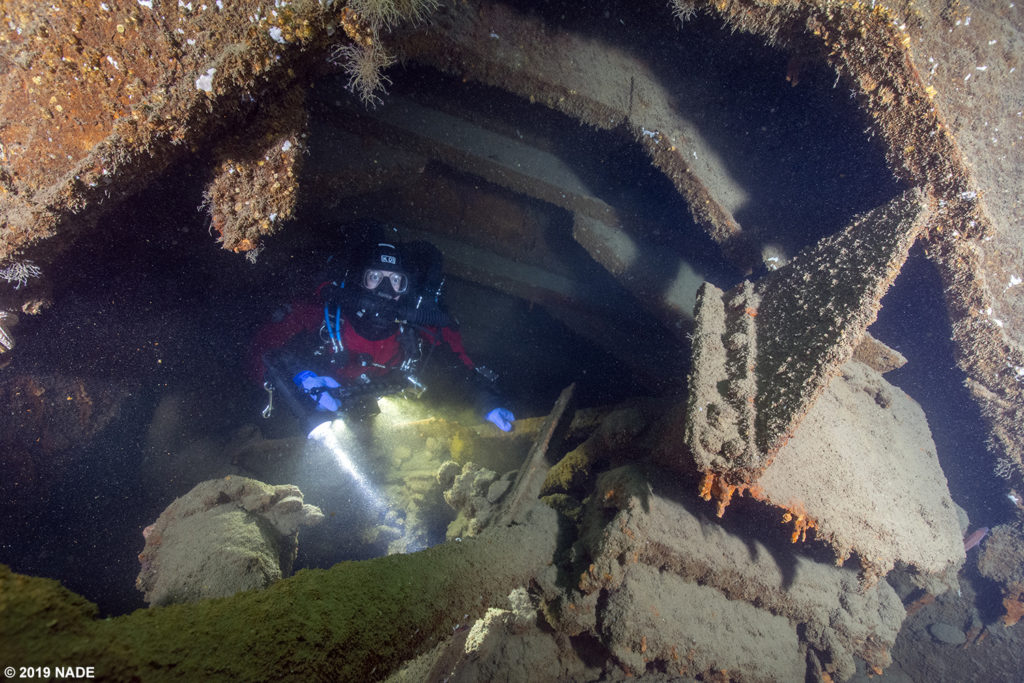
Tim coming out of a small space near the bow of the Pinthis.
In mid August we did something a little different and co-sponsored an event with Evolution Scuba focused on a day of learning, practicing skills and fun at Hathaway Pond. As most know, Dave and I recently began doing training with GUE and have been supporting efforts to bring some more GUE prominence into the area. Our goal is simply to see divers getting high quality training and offering highly experienced divers the opportunity to “brush up” with critical review and opportunities for self improvement. To that end, Dave and I took over the Facebook group “Massachusetts Underwater Explorers” (MAUE) and worked with Evolution Scuba to put together a diver event. The event was open to all divers, not just GUE trained divers. The day began with land-based lectures and drills, and then an in-water session. We had about 25 attendees of all levels from newly OW certified to advanced CCR trimix divers. Oh and of course we had a BBQ! No dive event is complete without a burger, folks. Some photos of the event are posted on the MAUE Facebook Page. We hope to offer this again next year so if you think you might be interested in GUE oriented training, networking or simply learning more, this would be worth checking out.
Another highlight of this summer was a major upgrade of our electronics aboard Gauntlet. Unfortunately, our fish finder decided to die at an extremely inopportune time over the July 4th holiday weekend and despite all efforts to secure a replacement quickly, we weren’t able to get one in time to stick with our original schedule for that weekend. And while we did get a replacement in time for the following weekend (matching a unit compatible with a 15 year old transducer to avoid a haul out meant we could only buy one type of unit), we decided it was really long overdue for a major upgrade.
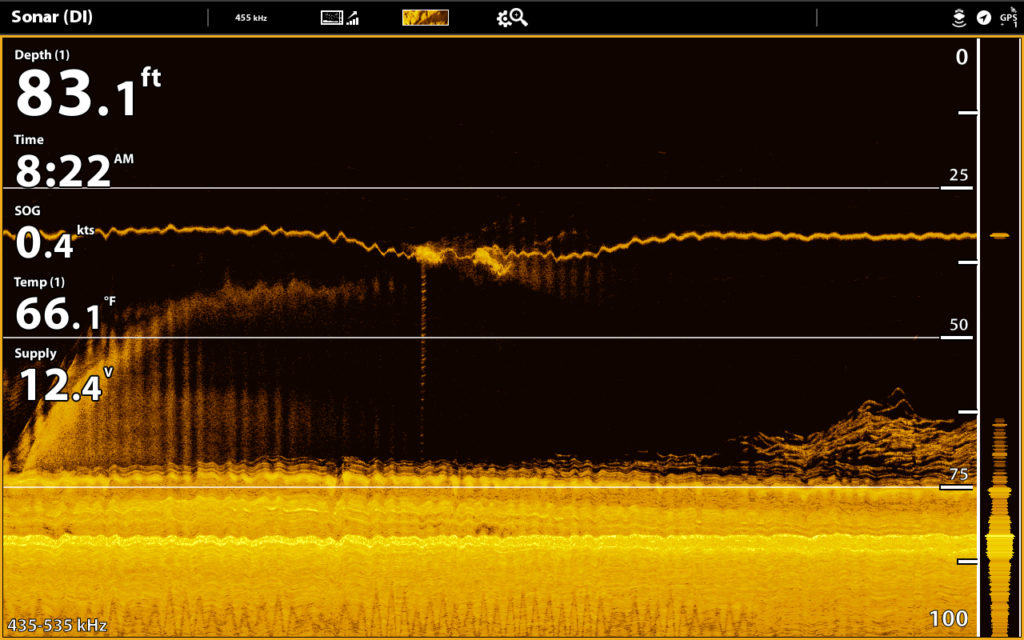
Humminbird Solix down-imaging view of divers on the granny line. We can check your trim from the surface!
We decided to “go big or go home” although that might just be “go broke” and get the boat really tricked out with the latest technology, which included our long desired installation of the Humminbird Solix, which offers a poor man’s sort of side scan sonar with what is quite honestly very impressive technology given it is side-imaging and down-imaging with a pair of transducers. We performed the installation of the transducers during Gauntlet’s annual haul-out and the following week had installers from Voyager Electronics wiring everything. This was quite a job and took both a lot of research to ensure we had the right components and some expertise to install it properly with NMEA2000 connections allowing all the machines to “talk” to each other. Yeah, it’s really freakin’ cool.
Part of the reason we wanted the Humminbird set up was to help provide more information for our exploration projects when looking at targets we have difficulty discerning on the bottom, but ones where we are also not ready to invest in the effort and cost of bringing a side scan sonar out to evaluate. The technology is quite good with both side-imaging (most similar to what you’d see from a traditional side scan sonar unit) and down-imaging, which can provide a cut-away type cross-sectional or side view of a target. Although these aren’t marketed for shipwreck imaging and deeper water wrecks won’t have the same quality of image as something in shallow water, the technology works and is good enough for our purposes. This type of imaging will allow us to see what we might have and get an idea of its structure, orientation and possibly even vessel type. We’ve just started using it and have lots to learn, but we can practice on known wrecks to get an idea of what things look like. Plus it’s cool and fun to play with!
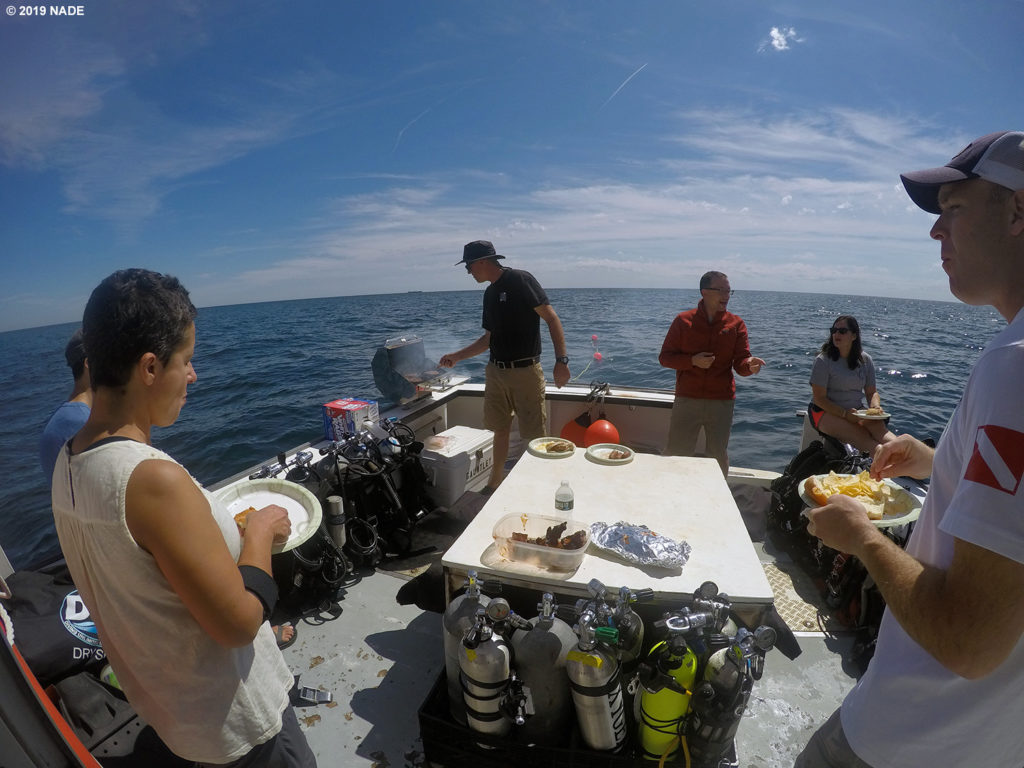
Chow time on the Pinthis! No shortage of meat available, although we are vegan friendly!
As August went by, we distinctly felt Fall creeping up on us–Northeast wind, bad visibility and yep, a blow out. Nevertheless we pressed on. And this brings us to Labor Day weekend, sigh. Already? Wow, time really went by fast this summer. On Labor Day weekend we had our final trip to the Pinthis planned, along with a local trip to the Herbert. We were able to get our Pinthis trip in, but sadly the visibility was not too good. And on Sunday, our Herbert trip ended up being a Poling trip in choppy seas and very bad visibility. Offshore low pressure systems and hurricane activity increasing did a number on the visibility with persistent surge keeping things churned. But we did have a BBQ on the Pinthis! That’s the great thing about Pinthis trips. Even if the visibility stinks, the food will be good!
Now we are into mid September. Hurricanes are in the Atlantic. We’re blown out and hence I have time to write a long dive report–a sure sign of the impending arrival of Fall in New England. That’s ok though. It has been a really great dive season, not without it’s ups and downs, but overall a really fun stretch of a few months diving cool places with friends. We’re pretty darn lucky we get to do this every weekend.
So what’s next? Well, we will continue to run Gauntlet on a more limited schedule as Fall and Winter arrive. We will remain in the water at Glover Wharf Marina through the winter, so there’s always the possibility of a few winter trips, but honestly in the last few years the harsh winter weather has barely allowed it. In the meantime, we have some late fall travel planned and our schedule will otherwise run through the end of December. Look for the next recap in our annual newsletter “The Lookout.”
Thank you to all our customers and crew aboard Gauntlet for your support and participation!
